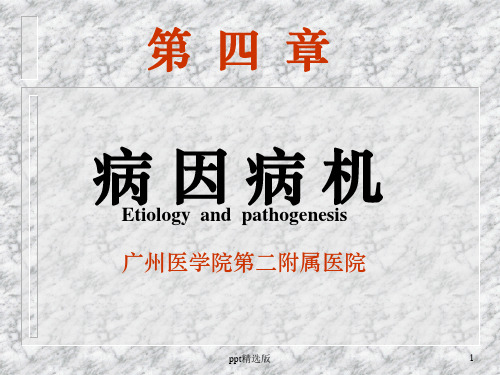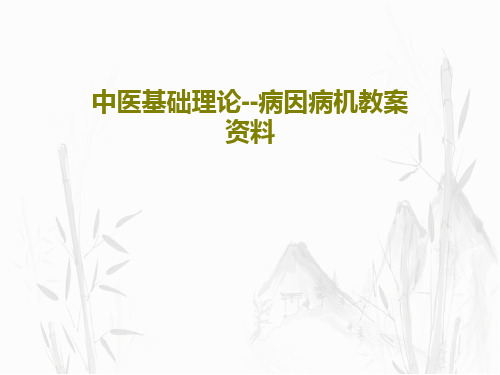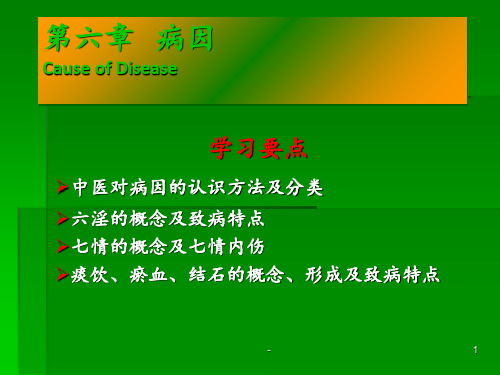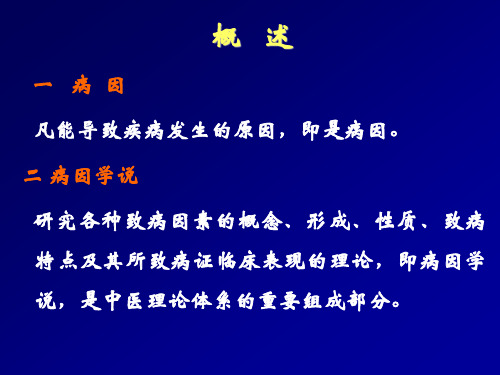中医基础理论之病因篇ppt课件
合集下载
《中医基础理论》病因 PPT课件

4、湿邪 Dampness
凡致病具有重浊、粘滞、趋下特性的外邪, 称为湿邪。
1.湿为阴邪,易阻气机、伤阳气 湿为阴邪,易损伤阳气 2.湿性重浊
湿性重浊,粘滞。当其侵犯人体最易留滞于 重:沉重—肢体沉重、头坠重、乏力、 脏腑经络,阻遏气机,使脏腑经络气机失 3. 湿性粘滞 ( 粘腻、停滞) 关节疼痛重着。 常,经络阻滞不畅。 A:病症——粘滞性 浊:分泌物、排泄物秽浊不清。 4.湿性趋下,易袭阴位 B:病程——缠绵性 湿邪为重浊有质之邪,类水属阴而有趋下 之势,人体下部亦属于阴,同类相求,故 18 医学课件 湿邪致病多伤及人体的下部。
1.《内经》:将病因分为阴阳两类。 2.张仲景:将病因按其传变概括为三个途 《素问.调经论》说:“夫邪之生也, 径(《金匮要略》)。 或生于阴,或生于阳,其生于阳者,得之 3.风雨寒暑,其生于阴者,得之饮食居处, 陈无择:在张仲景分类的基础上将病因 千般灾难,不越三条:一者,经络受 与发病途径结合在《三因极一病证方论》 阴阳喜怒。” 邪入脏腑,为内所因;二者,四肢九窍, 中具体阐明了“三因学说”。 血脉相传,壅塞不通,为外皮肤所中也; 六淫,天之常气,冒之则先自经络流入,内合于 三者,房室、金刃、虫兽所伤。以此详 脏腑,为外所因;七情,人之常性,动之则先自脏腑 之,病由都尽。 郁发,外形于肢体,为内所因;其如饮食饥饱,叫呼
(2)热(火)邪性质及致病特点
1.火为阳邪,其性炎上
火、热升腾上炎 2.火易耗气伤津 胃火上攻—牙龈肿痛 3.风热上壅 火易生风动血 —头痛、咽喉肿痛 心火上炎 — 口舌生疮 生风:火热之邪侵犯人体,热灼肝经 ,耗 4.火易扰心神 肝火上炎—目赤肿痛 伤津液,筋脉失养,易引起肝风内动的病证。 5.火易致肿疡 动血:热迫血妄行,导致各种出血病症 热入血分,遏阻营血:化腐成脓
中医基础理论-病因病机PPT课件

1、疏泄失常上逆 2、肝不藏血而出血
悲则气消 忧则气郁
思则气结
恐则气下 惊则气乱
三、其它致病因素
外伤、烧烫伤、冻伤、虫兽伤
四、可致病的病理产物
1.痰饮:水液代谢障碍所形成 2.瘀血: 体内有血液停滞 3.结石:体内形成的沙石样物
ppt精选版
20
痰饮Phlegm Retention
肺脾肾三焦气化失调导致水津停 滞的产物。质地稀为“饮”,稠为“痰”。 无形之痰:表现有痰饮的特殊症状和 体征但又看不到排出实质性痰浊或饮 液一类病证。
2
(Etiology)
破坏人体自身相对平衡状态而
引发疾病的原因。
中医认识病因的方法主要是 以临床表现为依据,通过对症状、 体征的分析来推求病因。 “审证求因 ”“天人相应”
病因
气候因素 六淫 疫疠
生活因素
情志 饮食 劳逸 外伤
病理产物 痰饮 瘀血 结石
六 太过 导致人体发病 六
气
不及 急骤变化
三:六淫的性质(热和、致病温特)邪点
1.为火阳邪,其性炎上
火、热升腾上炎
2.火易胃扰火上心攻神—牙龈肿痛
风热上壅—头痛、咽喉肿痛
3.火易心肝生火火上上风炎炎动— —血口 目舌 赤生 肿疮 痛 颈项4生强.火直风、易:角耗热弓灼反气肝张经伤。,筋津脉失养,四肢抽搐、两目上视、
动血:热迫血妄行,导致各种出血病症
等机能与物质相互关系的失调,以及表里、出入、 升降等气机的失常)
1、阴阳失调与发病
致病因素作用于人体,必须通过机 体内部阴阳失调才能形成疾病。因此阴阳失 调是疾病发生、发展、变化的内在依据
ppt精选版
29
二、阴阳失调
2、阴阳盛衰与寒热变化
悲则气消 忧则气郁
思则气结
恐则气下 惊则气乱
三、其它致病因素
外伤、烧烫伤、冻伤、虫兽伤
四、可致病的病理产物
1.痰饮:水液代谢障碍所形成 2.瘀血: 体内有血液停滞 3.结石:体内形成的沙石样物
ppt精选版
20
痰饮Phlegm Retention
肺脾肾三焦气化失调导致水津停 滞的产物。质地稀为“饮”,稠为“痰”。 无形之痰:表现有痰饮的特殊症状和 体征但又看不到排出实质性痰浊或饮 液一类病证。
2
(Etiology)
破坏人体自身相对平衡状态而
引发疾病的原因。
中医认识病因的方法主要是 以临床表现为依据,通过对症状、 体征的分析来推求病因。 “审证求因 ”“天人相应”
病因
气候因素 六淫 疫疠
生活因素
情志 饮食 劳逸 外伤
病理产物 痰饮 瘀血 结石
六 太过 导致人体发病 六
气
不及 急骤变化
三:六淫的性质(热和、致病温特)邪点
1.为火阳邪,其性炎上
火、热升腾上炎
2.火易胃扰火上心攻神—牙龈肿痛
风热上壅—头痛、咽喉肿痛
3.火易心肝生火火上上风炎炎动— —血口 目舌 赤生 肿疮 痛 颈项4生强.火直风、易:角耗热弓灼反气肝张经伤。,筋津脉失养,四肢抽搐、两目上视、
动血:热迫血妄行,导致各种出血病症
等机能与物质相互关系的失调,以及表里、出入、 升降等气机的失常)
1、阴阳失调与发病
致病因素作用于人体,必须通过机 体内部阴阳失调才能形成疾病。因此阴阳失 调是疾病发生、发展、变化的内在依据
ppt精选版
29
二、阴阳失调
2、阴阳盛衰与寒热变化
中医基础理论--病因病机教案资料60页PPT

中医基础理论--病因病机教案 资料
11、战争满足了,或曾经满足过人的 好斗的 本能, 但它同 时还满 足了人 对掠夺 ,破坏 以及残 酷的纪 律和专 制力的 欲望。 ——查·埃利奥 特 12、不应把纪律仅仅看成教育的手段 。纪律 是教育 过程的 结果, 首先是 学集 体表现 在一切 生活领 域—— 生产、 日常生 活、学 校、文 化等领 域中努 力的结 果。— —马卡 连柯(名 言网)
13、遵守纪律的风气的培养,只有领 导者本 身在这 方面以 身作则 才能收 到成效 。—— 马卡连 柯 14、劳动者的组织性、纪律性、坚毅 精神以 及同全 世界劳 动者的 团结一 致,是 取得最 后胜利 的保证 。—— 列宁 摘自名言网
15、机会是不守纪律的。——雨果
谢谢你的阅读
❖ 知识就是财富 ❖ 丰富你的人生
71、既然我已经踏上这条道路,那么,任何东西都不应妨碍我沿着这条路走下去。——康德 72、家庭成为快乐的种子在外也不致成为障碍物但在旅行之际却是夜间的伴侣。——西塞罗 73、坚持意志伟大的事业需要始终不渝的精神。——伏尔泰 74、路漫漫其修道远,吾将上下而求索。——屈原 75、内外相应,言行相称。——韩非
11、战争满足了,或曾经满足过人的 好斗的 本能, 但它同 时还满 足了人 对掠夺 ,破坏 以及残 酷的纪 律和专 制力的 欲望。 ——查·埃利奥 特 12、不应把纪律仅仅看成教育的手段 。纪律 是教育 过程的 结果, 首先是 学集 体表现 在一切 生活领 域—— 生产、 日常生 活、学 校、文 化等领 域中努 力的结 果。— —马卡 连柯(名 言网)
13、遵守纪律的风气的培养,只有领 导者本 身在这 方面以 身作则 才能收 到成效 。—— 马卡连 柯 14、劳动者的组织性、纪律性、坚毅 精神以 及同全 世界劳 动者的 团结一 致,是 取得最 后胜利 的保证 。—— 列宁 摘自名言网
15、机会是不守纪律的。——雨果
谢谢你的阅读
❖ 知识就是财富 ❖ 丰富你的人生
71、既然我已经踏上这条道路,那么,任何东西都不应妨碍我沿着这条路走下去。——康德 72、家庭成为快乐的种子在外也不致成为障碍物但在旅行之际却是夜间的伴侣。——西塞罗 73、坚持意志伟大的事业需要始终不渝的精神。——伏尔泰 74、路漫漫其修道远,吾将上下而求索。——屈原 75、内外相应,言行相称。——韩非
中医基础理论.病因ppt课件

3 食类偏嗜: 专食或厌食某类食品 损伤脾胃、湿热痰浊
ppt课件
中医基础理论精品课程
36
第五节:劳逸失度
一、过劳 1、劳力过度 2、劳神过度 3、房劳过度 二、过逸
过度安闲、缺乏劳动锻炼
ppt课件
中医基础理论精品课程
37
中医基础理论精品课程
一、过劳 1、劳力过度
损耗机体之气:少气懒言、精神疲惫、形体消瘦 2、劳神过度
特点: 内伤病因与外感病因相对而言,其直接损伤内 脏精气,可引起多种情志病和身心疾病。
ppt课件
25
中医基础理论精品课程
七情的基本概念
概念:七情指喜、怒、忧、思、悲、恐、惊七种情 志活动。
七情的生理:正常的七情是人体对客观事物的七种 不同的情志反应。
ppt课件
26
中医基础理论精品课程
七情的表现形式
中医基础理论精品课程
一、饮食不节
1、过饥:营养不足、气血亏虚、正气虚弱 2、过饱:食伤脾胃、宿食积滞、郁而化热(痢疾、
痔疮) 3、饮食规律失常:脾胃虚弱 二、饮食不洁 1、饮食变质 2、饮食污染 3、寄生虫
ppt课件
35
三、饮食偏嗜
1 偏寒偏热 偏寒:损伤脾阳、脾胃虚寒 偏热:损伤脾阴、胃热 2 五味偏嗜 酸、苦、甘、辛、咸 五味伤五脏
4
中医基础理论精品课程
目前常用中医病因分类
1.六淫:外感病因 2.疠气:外感病因 3.七情内伤 4.饮食失宜 5.劳逸失度 6.病理产物:痰饮、瘀血、 结石。 7.其他病因:外伤、胎传等。
ppt课件
5
中医基础理论精品课程
第一节:六 淫
概述: 六淫为外感病因之一,气候变化或抵抗力低下 时引起外感病发生。
ppt课件
中医基础理论精品课程
36
第五节:劳逸失度
一、过劳 1、劳力过度 2、劳神过度 3、房劳过度 二、过逸
过度安闲、缺乏劳动锻炼
ppt课件
中医基础理论精品课程
37
中医基础理论精品课程
一、过劳 1、劳力过度
损耗机体之气:少气懒言、精神疲惫、形体消瘦 2、劳神过度
特点: 内伤病因与外感病因相对而言,其直接损伤内 脏精气,可引起多种情志病和身心疾病。
ppt课件
25
中医基础理论精品课程
七情的基本概念
概念:七情指喜、怒、忧、思、悲、恐、惊七种情 志活动。
七情的生理:正常的七情是人体对客观事物的七种 不同的情志反应。
ppt课件
26
中医基础理论精品课程
七情的表现形式
中医基础理论精品课程
一、饮食不节
1、过饥:营养不足、气血亏虚、正气虚弱 2、过饱:食伤脾胃、宿食积滞、郁而化热(痢疾、
痔疮) 3、饮食规律失常:脾胃虚弱 二、饮食不洁 1、饮食变质 2、饮食污染 3、寄生虫
ppt课件
35
三、饮食偏嗜
1 偏寒偏热 偏寒:损伤脾阳、脾胃虚寒 偏热:损伤脾阴、胃热 2 五味偏嗜 酸、苦、甘、辛、咸 五味伤五脏
4
中医基础理论精品课程
目前常用中医病因分类
1.六淫:外感病因 2.疠气:外感病因 3.七情内伤 4.饮食失宜 5.劳逸失度 6.病理产物:痰饮、瘀血、 结石。 7.其他病因:外伤、胎传等。
ppt课件
5
中医基础理论精品课程
第一节:六 淫
概述: 六淫为外感病因之一,气候变化或抵抗力低下 时引起外感病发生。
中医基础理论之病因篇ppt课件

Rubella, characteristic of constantly changing
Vergo, convulsion, spasm, opisthotonus,
Being mobile Characterized by sway upward squint
Being primary pathogen
性质
致病特点
主要病症
伤寒:恶寒、无汗
寒为阴邪 寒证,伤阳气 中寒:脘腹冷痛、呕吐腹 泻伴有形寒肢冷。
凝滞
气血运行迟滞甚至 局部冷痛,遇热缓解,遇 凝结不通产生疼痛 冷加重
收引
腠理汗孔收缩 恶寒、无汗、发热 筋脉牵引拘急 四肢拘急,屈伸不利
-
8
Cold pathogen
All exogenous pathogenic factors characteristic of cold, coagulation and contraction are called cold pathogen.
dispersing
pore
Being mobile and
chanห้องสมุดไป่ตู้eable
Characterized by migratory location, sudden onset and
constantly changing
Migratory arthralgia(migratory pain in the jounts of the four limbs)
factors七情内伤 ▪ Phlegm-fluid retention痰
饮 ▪ Stagnant blood瘀血 ▪ Abdominal mass 徵积 ▪ Calculus结石
Vergo, convulsion, spasm, opisthotonus,
Being mobile Characterized by sway upward squint
Being primary pathogen
性质
致病特点
主要病症
伤寒:恶寒、无汗
寒为阴邪 寒证,伤阳气 中寒:脘腹冷痛、呕吐腹 泻伴有形寒肢冷。
凝滞
气血运行迟滞甚至 局部冷痛,遇热缓解,遇 凝结不通产生疼痛 冷加重
收引
腠理汗孔收缩 恶寒、无汗、发热 筋脉牵引拘急 四肢拘急,屈伸不利
-
8
Cold pathogen
All exogenous pathogenic factors characteristic of cold, coagulation and contraction are called cold pathogen.
dispersing
pore
Being mobile and
chanห้องสมุดไป่ตู้eable
Characterized by migratory location, sudden onset and
constantly changing
Migratory arthralgia(migratory pain in the jounts of the four limbs)
factors七情内伤 ▪ Phlegm-fluid retention痰
饮 ▪ Stagnant blood瘀血 ▪ Abdominal mass 徵积 ▪ Calculus结石
中医基础理论病因发病课件

异常变化:太过、不及、非其时而有其气、 气候变化过于剧烈。
人体的正气不足,抵抗力下降,不 能适应气候变化。
•中医基础理论病因发病
•15
六淫
六淫的致病的共同特点
• • • •
• 转化性
•中医基础理论病因发病
•16
风邪
风邪,凡致病具有善动不居、 轻扬开泄等特性的外邪,称为 风邪。 风邪的性质和致病特点
病因 发病
•中医基础理论病因发病
•1
病因
概说 外感性致病因素 内伤性致病因素 病理产物类致病因素 其他病因
•中医基础理论病因发病
•2
概说
•中医基础理论病因发病
•3
概说
病因,是指引起人体发生疾病的 原因,亦称致病因素、病源、病 邪等。
如:六淫、疠气、七情、饮食、劳 逸、外伤及病理产物形成的病因 (痰饮、瘀血、结石)等。
暑为盛夏火热之气所化,故属阳邪。 “阳胜则热”,故暑邪致病,常见壮热、 面赤、心烦、脉象洪大。
•中医基础理论病因发病
•38
暑邪
2.暑性升散,扰神伤津耗气
暑与心相通,易上扰心神。 暑为火热之气,主升主散,可致腠理开泄 而伤津耗气。 临床表现 心胸烦闷不宁,或突然昏倒。
汗多,口渴喜饮、小便短赤,气短乏力 等。
寒邪之中少阴,可见恶寒蜷卧、手足厥 冷、下利清谷、小便清长、精神萎靡、脉 微细等。
•中医基础理论病因发病
•23
寒邪
2.
寒性凝滞,指寒邪致病,易使经脉气血津 液凝结、经脉阻滞。
寒客肌表经络,气血凝滞不通,则见头身 肢体关节疼痛。
痛痹,以关节冷痛为主。
寒邪直中胃肠,脘腹冷痛。
寒客肝脉,见少腹、阴部冷痛。
• 风为阳邪,轻扬开泄,易袭阳位 • 风性善行而数变 • 风性主动 • 风为百病之长
人体的正气不足,抵抗力下降,不 能适应气候变化。
•中医基础理论病因发病
•15
六淫
六淫的致病的共同特点
• • • •
• 转化性
•中医基础理论病因发病
•16
风邪
风邪,凡致病具有善动不居、 轻扬开泄等特性的外邪,称为 风邪。 风邪的性质和致病特点
病因 发病
•中医基础理论病因发病
•1
病因
概说 外感性致病因素 内伤性致病因素 病理产物类致病因素 其他病因
•中医基础理论病因发病
•2
概说
•中医基础理论病因发病
•3
概说
病因,是指引起人体发生疾病的 原因,亦称致病因素、病源、病 邪等。
如:六淫、疠气、七情、饮食、劳 逸、外伤及病理产物形成的病因 (痰饮、瘀血、结石)等。
暑为盛夏火热之气所化,故属阳邪。 “阳胜则热”,故暑邪致病,常见壮热、 面赤、心烦、脉象洪大。
•中医基础理论病因发病
•38
暑邪
2.暑性升散,扰神伤津耗气
暑与心相通,易上扰心神。 暑为火热之气,主升主散,可致腠理开泄 而伤津耗气。 临床表现 心胸烦闷不宁,或突然昏倒。
汗多,口渴喜饮、小便短赤,气短乏力 等。
寒邪之中少阴,可见恶寒蜷卧、手足厥 冷、下利清谷、小便清长、精神萎靡、脉 微细等。
•中医基础理论病因发病
•23
寒邪
2.
寒性凝滞,指寒邪致病,易使经脉气血津 液凝结、经脉阻滞。
寒客肌表经络,气血凝滞不通,则见头身 肢体关节疼痛。
痛痹,以关节冷痛为主。
寒邪直中胃肠,脘腹冷痛。
寒客肝脉,见少腹、阴部冷痛。
• 风为阳邪,轻扬开泄,易袭阳位 • 风性善行而数变 • 风性主动 • 风为百病之长
中医基础理论ppt——第六章-病因

第十五页,共一百一十九页。
风邪
性质及致病特点
二.风性善行而数变
善行 行无定处 病位游移不定 如行痹之游走性关节疼痛 风邪
数变 多变 起病急,变化快 如风疹之发病急骤,变化迅速
风温(流脑)初起仅见发热、恶寒等肺卫表证,, 但可迅速入里而见高热、神昏、惊厥等热闭 心包等危重证候。
第十六页,共一百一十九页。
目的与要求
1.掌握六淫的概念和共同致病特点,六淫各自的
性质与致病特点。
2.掌握七情的概念,七情与内脏精气的关系,七 情内伤的致病特点。
3.掌握痰饮、瘀血、结石的基本概念、致病特点。
4.熟悉病因的概念及病因学说的特点。
5.熟悉饮食失宜、劳逸失度的致病特点。 6.了解痰饮、瘀血、结石的形成原因。
第一页,共一百一十九页。
三、湿性黏滞 1、症状的黏腻性——分泌物及排泄物涩滞不畅。 如:痢疾大便排泄不爽;淋证小便涩滞不畅。 2、病程的缠绵性——如湿温、湿疹、湿痹等 反复发作,缠绵难愈。
第三十四页,共一百一十九页。
湿邪
性质及致病特点
四、湿性趋下,易袭阴位
湿邪为病,多侵袭人体的下部。如水肿、湿疹等病以 下肢多见。另常见二便异常,女子带下异常。
概述
中医病因的分类及沿革:
4.陈无择的三因分类法—“三因学说”
• 外所因:六淫
• 内所因:七情
• 不内外因:饮食劳倦、 跌仆金刃、虫兽所伤
第七页,共一百一十九页。
目前中医基础理论教材及病因病机学专著,基
本上只从单一病因方面阐释病因的致病特点和规律。
病理
产物
饮食
中医主要病因
劳逸
六淫
七情
第八页,共一百一十九页。
停 滞 性 病程的缠绵性,起病缓,传变慢,病程迁延,缠 绵难愈
中医基础理论病因PPT课件

望诊
脉诊
固不 定移
刺固拒
血夹
定 不
青紫 癥 色 有 肿胀 积 紫 血
痛移按
暗块
色 紫 暗
脉不 涩畅
面口爪舌 色唇甲质
涩迟 弦结 代
三结 石
结石,是指体内某些部位形成并停滞为 病的沙石样病理产物或结块。
(一)
结 石 的 形 成
饮食不当 情志内伤 用药不当 体质差异
(二) 结石的致病特点
➢ 1、多发于肝、肾、胆、胃、膀胱等脏腑 ➢ 2、病程较长,病情轻重不一。 ➢ 3、阻滞气机,损伤脉络。
2
寒邪 的性 质和 致病 特点
寒为阴邪,易伤阳气 寒性凝滞 寒性收引
寒为阴邪,易伤阳气 致病特点
寒证、伤阳证 主要病症
伤寒:恶寒、无汗
中寒:脘腹冷痛、呕吐腹泻 伴有形寒怕冷,四肢不温
寒性凝滞
致病特点
气血运行迟滞甚则 凝结不通产生疼痛
主要病症
伤寒:头身疼痛 寒痹:关节冷痛
中寒:脘腹冷痛
性质
寒性收引
二 七情与内脏精气的关系
一方面, 情志活动由脏腑精气应答在外在环境 因素的作用所产生,脏腑精气是内脏活动产生的 内在生理学基础。
另一方面,外在环境的变化过于强烈,情志过 激或持续不解,又可导致脏腑阴阳的功能失常, 气血运行失调。
三 七情内伤的致病特点
直接伤及内脏
致
影响脏腑气机
病
特
多发为情志病证
点
致病特点
临床症状
重
沉重感
浊
分泌物排泄 物秽浊不清
头重身困,四 肢发沉,关节 重着疼痛
小便混浊 , 大便溏泻、下 痢粘液脓血、 面垢眵多
致病特点
中医基础理论--病因病机 PPT课件

暑邪
(2)暑邪
①暑为阳邪,其性炎热
② 暑性升散,易耗气伤津 阳邪升散——腠理开泄——多汗
伤津耗液——口渴喜冷,小便短赤。 气随津脱——气虚——气短乏力 气津暴脱——神昏,肢冷,脉微弱。 气与津的关系:气能生津、行津、摄津,津能载 气。
③暑多挟湿 暑湿困脾 运化失职 纳呆、呕吐、便溏、尿少. 湿困清阳 胸闷、肢倦、苔腻、脉濡。
(3)出血——血色紫暗,夹有血块。 (4)望诊——面部、口唇、爪甲青紫,舌质紫暗或瘀 点,皮下紫斑,面色黧黑。
(5)脉诊——涩、迟、弦、结、代脉。
第二节 病机 病机,是疾病发生、发展、变化及其结局的机理。
一、正邪相争 正气——是指人体的机能活动及其产生的抗病、 康复能力。 邪气——泛指各种致病因素。 1、正气不足是发病的内在根据。 《内经》:“正气存内,邪不可干”,“邪之所凑, 其气必虚”。
病位在上
上扰清窍—头痛
②风性善行而数变 ③风为百病之长
风邪的性质及致病特点表
性质 致病特点
主要病症
轻扬开泄 病位在上 头痛、鼻塞、咽痒 病位在表 恶风、发热、汗出
善行数变 病位游走不定 行痹之四肢关节疼痛,游 症状变化多端 走不定,风疹之皮疹时隐 时现,此起彼伏
为百病长 多兼邪致病 风寒、风热、风湿、风寒 湿等兼夹证
(二)瘀血
瘀血是指血液运行不畅,或体内离经之血未能消 散者。
1、瘀血的形成
外伤——络伤血溢 血离脉道
外邪
气虚——气不摄血 停积于体
情志
血热——迫血妄行 内
饮食 损伤机体 气虚——血行无力
瘀
劳逸
气滞——血行受阻 血行不畅 血
外伤
血寒——寒凝血滞 阻滞于脏
血热——煎熬粘滞 腑经络
中医基础理论--病因病机99199PPT课件

主要病症
喜
心气涣散 心悸、失眠、精神不集
乐 过 度
喜伤心 喜则气缓
中 心神失常 喜笑不休、妄言、妄动
.
(3)悲则气消
病因 致病特点 主要病症
悲 哀 过 度
声低息微,气短乏力,
悲伤肺 肺气消散精神萎靡不振,甚则失
悲则气消
魂落魄
.
(4)恐则气下
病因 致病特点
主要病症
恐
气血趋下 面色苍白,头昏欲倒,
惧 过 恐伤肾
暑邪的性质及致病特点表
性质 致病特点
主要病症
炎热 实热证 高热,烦渴,面红,目赤,脉洪大
升散 上犯头目 伤暑:头昏、目眩
上扰心神 中暑:突然昏倒,不省人事
伤津耗气 口渴多饮,舌红少津,气短乏力
多夹湿 暑湿夹杂 身热不扬,烦渴,身重倦怠,胸闷,
证
呕恶,苔黄腻
.
湿邪
.
(3)湿邪
①湿为阴邪,易阻遏气机,损伤阳气
.
3、七情的致病特点 (1)损伤五脏
怒伤肝;喜伤心;思伤脾;悲伤肺;恐伤肾 (2)影响脏腑气机
.
①怒则气上
病因 致 病 特 点
主要症
肝气上逆
大怒 怒伤肝 怒则气上
血随气逆 影响脾胃
急燥易怒,头痛、头胀、 面红、目赤 吐血、呕血、甚则昏厥
嗳气、呕吐、腹胀、腹 泻、食欲不振
.
(2)喜则气缓
病因 致 病 特 点
病位在上
上扰清窍—头痛
②风性善行而数变
③风为百病之长
.
风邪的性质及致病特点表
性质
致病特点
主要病症
轻扬开泄 病位在上
头痛、鼻塞、咽痒
病位在表
《中医基础理论》病因PPT课件

详细描述
过度劳累会导致身体疲惫、肌肉劳损 ,甚至引发心脑血管疾病等严重后果 。过度安逸则会导致身体机能衰退、 免疫力下降,容易感染疾病。劳逸失 度还可能影响人体的气血流通,导致 气血不畅或气血不足,从而引发一系 列的疾病。
防治方法
为了预防劳逸失度,应该保持适度的 劳动和休息,避免过度劳累或过度安 逸。在工作和生活中,应合理安排时 间,适时休息和放松。同时,应根据 自身情况适量运动,增强身体素质和 免疫力。中医也提倡通过按摩、针灸 、中药等方法来调理身体,以缓解劳 逸失度对身体的影响。
谢谢观看
中医病因的分类
总结词
中医病因可分为外因和内因两大类,其中外因包括六淫和疫疠,内因包括七情和 饮食劳逸。
详细描述
外因是指从外部侵入人体的致病因素,包括风、寒、暑、湿、燥、火六淫和疫疠 等。内因则是人体内部的因素,包括七情、饮食劳逸等方面。这些因素相互作用 ,导致疾病的发生。
中医病因的特点
总结词
中医病因具有多因素性、相关性、动态性等特点。
饮食失宜
总结词
饮食失宜是指饮食习惯不良或食物选 择不当导致的身体健康问题,也是内 伤病因的一种。
详细描述
饮食失宜包括过饥过饱、偏食、暴饮 暴食等不良饮食习惯,以及食用过于 油腻、辛辣、生冷等刺激性食物。这 些行为会导致脾胃受损、消化功能失 调,进而引发气血不足、营养不良等 问题。长期饮食失宜还可能引发肥胖 、高血压、糖尿病等慢性疾病。
防治方法
为了预防饮食失宜,应该养成健康的 饮食习惯,如定时定量、荤素搭配、 少油少盐等。同时,应避免食用过于 刺激的食物,多吃蔬菜水果和易消化 的食物。中医也提倡通过食疗来调理 身体,如食用红枣、枸杞、山药等补 气血的食物,以缓解饮食失宜对身体 的影响。
中医基础理论-病因与发病 ppt课件

A暑为夏季主气,乃火热之气所化 先夏至日为病温 B暑邪与其他外邪不同,具有明显的季节性,且独见于夏令 后夏至日为病暑 C炎夏季节,气温过高 或烈日之下,长时间露天作业 感受暑热之邪而患病 或工作环境闷热 D暑纯属外邪,无“内暑”之说
第一节
病因
一、外感性致病因素
(一)六淫 (二)疠气
二、内伤性致病因素
(一)七情内伤 (二)饮食失宜 (三)劳逸失度
三、其它致病因素
(一)外伤、虫兽伤及寄生虫(二)痰饮(三)瘀血
ppt课件
8
(一ห้องสมุดไป่ตู้六淫
1六气与六淫的基本概念: 六气 指风、寒、暑、湿、燥、火六种正常的自然界气候。正常 情况下对人体是无害的。 六淫 即风、寒、暑、湿、燥、火六种外感病邪的统称。淫,即 太过和侵淫之意。 1气候变化异常,六气发生太过或不及 转化条件 2非其时而有其气(如春天应温 超过人体适应能力 而反寒,秋天应凉而反热等) 六气才能成为六淫 3气候变化过于急骤 (如暴冷、暴热等)
伤寒:寒邪伤于肌表, 郁遏卫阳 外寒 :外寒指外感寒邪而言 中寒:寒邪直中脏腑 寒病 内寒:机体阳气不足,机能衰退。 相互联系,相互影响 外寒损伤阳气导致内
寒病证阳虚内寒之体, 容易感受外寒
(2)寒邪性质和致病特点: ①寒为阴邪,易伤阳气 ②寒性凝滞 ③寒性收引
ppt课件 14
①寒为阴邪,易伤阳气:
ppt课件
6
四、中医发病学的特点
取决于
正气虚是疾病发生的内在根据 体质、精神状态、生活
环境及营养锻炼 1中医强调正气在发病中的地位 邪气盛是发病的外部条件。某些情况下邪气起决定性作用 2正气与邪气的斗争贯穿于疾病发展过程的始终 3正气与邪气矛盾双方的力量对比,决定着疾病发展的方向和转归
第一节
病因
一、外感性致病因素
(一)六淫 (二)疠气
二、内伤性致病因素
(一)七情内伤 (二)饮食失宜 (三)劳逸失度
三、其它致病因素
(一)外伤、虫兽伤及寄生虫(二)痰饮(三)瘀血
ppt课件
8
(一ห้องสมุดไป่ตู้六淫
1六气与六淫的基本概念: 六气 指风、寒、暑、湿、燥、火六种正常的自然界气候。正常 情况下对人体是无害的。 六淫 即风、寒、暑、湿、燥、火六种外感病邪的统称。淫,即 太过和侵淫之意。 1气候变化异常,六气发生太过或不及 转化条件 2非其时而有其气(如春天应温 超过人体适应能力 而反寒,秋天应凉而反热等) 六气才能成为六淫 3气候变化过于急骤 (如暴冷、暴热等)
伤寒:寒邪伤于肌表, 郁遏卫阳 外寒 :外寒指外感寒邪而言 中寒:寒邪直中脏腑 寒病 内寒:机体阳气不足,机能衰退。 相互联系,相互影响 外寒损伤阳气导致内
寒病证阳虚内寒之体, 容易感受外寒
(2)寒邪性质和致病特点: ①寒为阴邪,易伤阳气 ②寒性凝滞 ③寒性收引
ppt课件 14
①寒为阴邪,易伤阳气:
ppt课件
6
四、中医发病学的特点
取决于
正气虚是疾病发生的内在根据 体质、精神状态、生活
环境及营养锻炼 1中医强调正气在发病中的地位 邪气盛是发病的外部条件。某些情况下邪气起决定性作用 2正气与邪气的斗争贯穿于疾病发展过程的始终 3正气与邪气矛盾双方的力量对比,决定着疾病发展的方向和转归
中医基础理论--病因病机 PPT课件

36
基本病机
一、正邪相争 二、阴阳失调
三、气机失常
37
二、阴阳失调
阴阳失调 发病 寒热变化
阴阳盛衰
疾病转归
38
(一)阴阳失调与发病
阴阳相对的、动态的、平衡与协调
阴平阳秘
39
(二)阴阳偏胜—阳盛
1、病理状态:阳气偏盛,机能亢奋,代谢活动亢
进,机体反应性增强,阳热过剩。
2、病机特点:阳盛而阴未虚或虚亏不明显 3、临床表现:壮热、汗出、面赤、舌红、脉数 (实热证);口渴、尿赤、便干(阳盛则热)
3、影响发生与流行的因素
人体正气强弱有关
气候因素 环境和饮食因素 预防措施因素 社会因素
16
二、内伤致病因素
七 情
饮 食
劳 逸
17
(一) 七情
1、概述
七情:是指正常的喜、怒、忧、思、悲、恐、 惊七种情志变化。 内伤七情:是指异常的喜、怒、忧、思、悲、
恐、惊七种内伤病邪的统称。
18
2、七情与脏腑气血的关系
心-在志为喜
肝-在志为怒
脾-在志为思 肺-在志为忧 肾-在志为恐
19
3、七情的致病特点
(1)直接伤及内脏
怒伤肝 喜伤心 思伤脾 忧伤肺 恐伤肾
20
ห้องสมุดไป่ตู้
3、七情的致病特点
(2)影响脏腑气机
怒则气上 喜则气缓 悲则气消
恐则气下 惊则气乱 思则气结
(3)影响病情变化
21
(二)饮食失宜
素体虚弱 久病耗伤 思虑劳倦
主要在脾 中气下陷
52
(四)气闭
气之出入障碍,不能外达,闭郁结聚于内 壅于心胸 阳气内郁 肺气闭郁 腑气不通
- 1、下载文档前请自行甄别文档内容的完整性,平台不提供额外的编辑、内容补充、找答案等附加服务。
- 2、"仅部分预览"的文档,不可在线预览部分如存在完整性等问题,可反馈申请退款(可完整预览的文档不适用该条件!)。
- 3、如文档侵犯您的权益,请联系客服反馈,我们会尽快为您处理(人工客服工作时间:9:00-18:30)。
Under normal conditions, they are called “six climatic factors”
Common pathogenic characteristics of six excesses
1. exogenousness 2. seasonality 3. regionality 4. combination 5. transformability
2.七情 4.饮食 6.痰饮 8.结石 10.寄生虫 12.先天因素
13.医过等
1.生物病原:如细菌、病毒、真菌等。 2.物理因素:如噪音、高温、气压、放射线等。 3.化学因素:如化学药品、污染、毒物等。 4.营养因素:如偏食、营养不良等。 5.精神因素:如情绪、心理等。 6.遗传因素:如遗传病等。
factors.
➢Methods of CM probing into pathogenic
factors
➢ Asking directly
➢ Referring the cause by syndrome
differentiation
.
3
中医病因 西医病因
1.六淫 3.疠气 5.劳逸 7.瘀血 9.外伤 11.药邪
.
5
一、风
自然界中具有风之轻扬开泄、善动不居特性的外邪,称为风邪。
性质
轻扬开泄 (浮越)
善行数变
主动 为百病之长
致病端
动摇不定
致病先导
头痛、鼻塞、咽痒。
恶风、发热、汗出。
行痹之四肢关节疼痛,游 走不定。 风疹块之皮疹时隐时现, 此起彼伏。
眩晕、抽搐、拘挛、角弓 反张,两目上吊。
factors七情内伤 ▪ Phlegm-fluid retention痰
饮 ▪ Stagnant blood瘀血 ▪ Abdominal mass 徵积 ▪ Calculus结石
▪ Medicine pathogens药邪 ▪ Iatrogenic factors医过 ▪ Fetal weakness胎弱 ▪ Fetal toxin胎毒
.
2
Introduction
➢Concept:
➢ The cause of disease, refers to the factors that damage the relative epuilibrium and result in disease and are also called pathogenic
性质
致病特点
主要病症
伤寒:恶寒、无汗
寒为阴邪 寒证,伤阳气 中寒:脘腹冷痛、呕吐腹
泻伴有形寒肢冷。
凝滞
气血运行迟滞甚至 局部冷痛,遇热缓解,遇 凝结不通产生疼痛 冷加重
收引
腠理汗孔收缩 恶寒、无汗、发热 筋脉牵引拘急 四肢拘急,屈伸不利
.
8
Cold pathogen
All exogenous pathogenic factors characteristic of cold, coagulation and contraction are called cold pathogen.
.
4
第一节 六淫 Six Excesses
Concept of Six Excesses
The six excesses are a collective term used for six kinds of exogenous pathogens of wind, cold, summer-heat, dampness, dryness and fire.
Rubella, characteristic of constantly changing
Vergo, convulsion, spasm, opisthotonus,
Being mobile Characterized by sway upward squint
Being primary pathogen
dispersing
pore
Being mobile and
changeable
Characterized by migratory location, sudden onset and
constantly changing
Migratory arthralgia(migratory pain in the jounts of the four limbs)
natures
Pathogenic characteristics
Clinical nanifestations
Light and Being apt to attack yang portion Headache, stuffy nasal, itching throat. opening- of body and discharging the Aversion to wind, fever and sweating.
Tends to cause disease in mixture with
The precursor of various other pathogenic factors such as cold,
diseases
heat,dampness and dryness, etc
.
7
二、寒
自然界中具有寒冷、凝结特性的外邪,称为寒邪。
风寒、风热、风湿、风寒 湿等兼夹证。
.
6
Wind pathogen
All exogenous pathogenic factors characteristic of lightness, rising, and opening-dispersing and migrating are called wind pathogen.
第六章 病因
Cause of Disease
学习要点
➢中医对病因的认识方法及分类 ➢六淫的概念及致病特点 ➢七情的概念及七情内伤 ➢痰饮、瘀血、结石的概念、形成及致病特点
.
1
KEY WORDS
▪ Cause of disease病因 ▪ Etiology 病因学说 ▪ Six excesses六淫 ▪ Pestilential qi疠气 ▪ Seven emotions七情 ▪ Interal-injury pathogenic
Common pathogenic characteristics of six excesses
1. exogenousness 2. seasonality 3. regionality 4. combination 5. transformability
2.七情 4.饮食 6.痰饮 8.结石 10.寄生虫 12.先天因素
13.医过等
1.生物病原:如细菌、病毒、真菌等。 2.物理因素:如噪音、高温、气压、放射线等。 3.化学因素:如化学药品、污染、毒物等。 4.营养因素:如偏食、营养不良等。 5.精神因素:如情绪、心理等。 6.遗传因素:如遗传病等。
factors.
➢Methods of CM probing into pathogenic
factors
➢ Asking directly
➢ Referring the cause by syndrome
differentiation
.
3
中医病因 西医病因
1.六淫 3.疠气 5.劳逸 7.瘀血 9.外伤 11.药邪
.
5
一、风
自然界中具有风之轻扬开泄、善动不居特性的外邪,称为风邪。
性质
轻扬开泄 (浮越)
善行数变
主动 为百病之长
致病端
动摇不定
致病先导
头痛、鼻塞、咽痒。
恶风、发热、汗出。
行痹之四肢关节疼痛,游 走不定。 风疹块之皮疹时隐时现, 此起彼伏。
眩晕、抽搐、拘挛、角弓 反张,两目上吊。
factors七情内伤 ▪ Phlegm-fluid retention痰
饮 ▪ Stagnant blood瘀血 ▪ Abdominal mass 徵积 ▪ Calculus结石
▪ Medicine pathogens药邪 ▪ Iatrogenic factors医过 ▪ Fetal weakness胎弱 ▪ Fetal toxin胎毒
.
2
Introduction
➢Concept:
➢ The cause of disease, refers to the factors that damage the relative epuilibrium and result in disease and are also called pathogenic
性质
致病特点
主要病症
伤寒:恶寒、无汗
寒为阴邪 寒证,伤阳气 中寒:脘腹冷痛、呕吐腹
泻伴有形寒肢冷。
凝滞
气血运行迟滞甚至 局部冷痛,遇热缓解,遇 凝结不通产生疼痛 冷加重
收引
腠理汗孔收缩 恶寒、无汗、发热 筋脉牵引拘急 四肢拘急,屈伸不利
.
8
Cold pathogen
All exogenous pathogenic factors characteristic of cold, coagulation and contraction are called cold pathogen.
.
4
第一节 六淫 Six Excesses
Concept of Six Excesses
The six excesses are a collective term used for six kinds of exogenous pathogens of wind, cold, summer-heat, dampness, dryness and fire.
Rubella, characteristic of constantly changing
Vergo, convulsion, spasm, opisthotonus,
Being mobile Characterized by sway upward squint
Being primary pathogen
dispersing
pore
Being mobile and
changeable
Characterized by migratory location, sudden onset and
constantly changing
Migratory arthralgia(migratory pain in the jounts of the four limbs)
natures
Pathogenic characteristics
Clinical nanifestations
Light and Being apt to attack yang portion Headache, stuffy nasal, itching throat. opening- of body and discharging the Aversion to wind, fever and sweating.
Tends to cause disease in mixture with
The precursor of various other pathogenic factors such as cold,
diseases
heat,dampness and dryness, etc
.
7
二、寒
自然界中具有寒冷、凝结特性的外邪,称为寒邪。
风寒、风热、风湿、风寒 湿等兼夹证。
.
6
Wind pathogen
All exogenous pathogenic factors characteristic of lightness, rising, and opening-dispersing and migrating are called wind pathogen.
第六章 病因
Cause of Disease
学习要点
➢中医对病因的认识方法及分类 ➢六淫的概念及致病特点 ➢七情的概念及七情内伤 ➢痰饮、瘀血、结石的概念、形成及致病特点
.
1
KEY WORDS
▪ Cause of disease病因 ▪ Etiology 病因学说 ▪ Six excesses六淫 ▪ Pestilential qi疠气 ▪ Seven emotions七情 ▪ Interal-injury pathogenic
